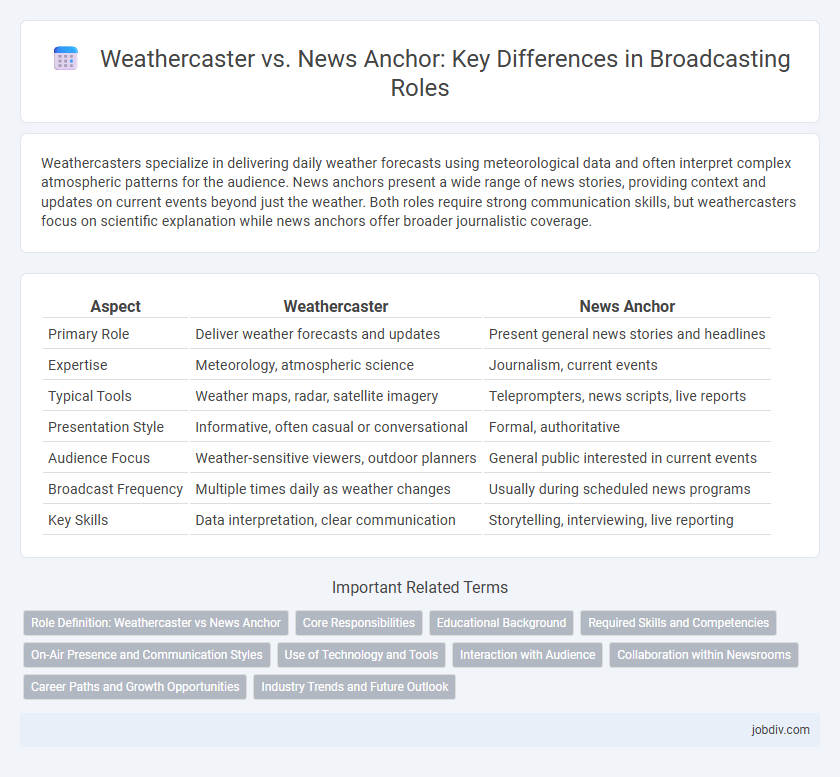Weathercasters specialize in delivering daily weather forecasts using meteorological data and often interpret complex atmospheric patterns for the audience. News anchors present a wide range of news stories, providing context and updates on current events beyond just the weather. Both roles require strong communication skills, but weathercasters focus on scientific explanation while news anchors offer broader journalistic coverage.
Table of Comparison
| Aspect | Weathercaster | News Anchor |
|---|---|---|
| Primary Role | Deliver weather forecasts and updates | Present general news stories and headlines |
| Expertise | Meteorology, atmospheric science | Journalism, current events |
| Typical Tools | Weather maps, radar, satellite imagery | Teleprompters, news scripts, live reports |
| Presentation Style | Informative, often casual or conversational | Formal, authoritative |
| Audience Focus | Weather-sensitive viewers, outdoor planners | General public interested in current events |
| Broadcast Frequency | Multiple times daily as weather changes | Usually during scheduled news programs |
| Key Skills | Data interpretation, clear communication | Storytelling, interviewing, live reporting |
Role Definition: Weathercaster vs News Anchor
Weathercasters specialize in delivering accurate meteorological information, interpreting weather data from radar, satellites, and forecasts to inform viewers about current and upcoming weather conditions. News anchors present a broad range of news stories, including politics, economics, and human interest, ensuring clear communication and maintaining the program's flow. Each role requires distinct expertise: weathercasters are trained in atmospheric science, while news anchors focus on journalism and story presentation.
Core Responsibilities
Weathercasters specialize in interpreting meteorological data and presenting weather forecasts clearly to inform the public about current and upcoming atmospheric conditions. News anchors focus on delivering a broad range of news stories, maintaining journalistic standards, and coordinating with reporters to provide accurate, timely information. Both roles require effective communication skills but differ primarily in content expertise and presentation style.
Educational Background
Weathercasters typically hold degrees in meteorology, atmospheric science, or related fields, emphasizing scientific knowledge essential for accurate weather reporting. News anchors often possess backgrounds in journalism, communications, or media studies, providing skills in storytelling, broadcasting, and audience engagement. Both roles require specialized training, but the educational foundations reflect their distinct professional responsibilities in broadcasting.
Required Skills and Competencies
Weathercasters require strong meteorological knowledge, proficiency with weather forecasting technology, and the ability to interpret complex data for diverse audiences. News anchors must excel in clear communication, quick thinking, and interviewing, combined with a deep understanding of current events and editorial judgment. Both roles demand excellent on-camera presence, adaptability, and strong verbal skills to engage viewers effectively.
On-Air Presence and Communication Styles
Weathercasters exhibit a dynamic on-air presence characterized by energetic gestures and engaging visuals to simplify complex meteorological data. News anchors maintain a composed and authoritative demeanor, delivering information with clarity and professionalism to build viewer trust. Their communication styles reflect distinct goals: weathercasters emphasize approachability and explanation, while news anchors focus on delivering unbiased and concise news coverage.
Use of Technology and Tools
Weathercasters utilize specialized meteorological software and Doppler radar systems to interpret and present real-time weather data accurately. News anchors rely on advanced teleprompters, video editing tools, and newsroom automation systems to deliver seamless and timely news broadcasts. Both roles increasingly integrate augmented reality and digital graphics to enhance viewer engagement and comprehension.
Interaction with Audience
Weathercasters often engage with the audience through dynamic visuals and real-time weather updates, creating a more interactive and visually stimulating experience. News anchors primarily focus on delivering comprehensive news stories with a formal tone, fostering trust and credibility through clear communication. Both roles require strong communication skills but differ in their approach to audience interaction, with weathercasters leveraging multimedia tools and anchors emphasizing narrative clarity.
Collaboration within Newsrooms
Weathercasters and news anchors collaborate closely in newsrooms to deliver cohesive and timely broadcast content, ensuring seamless transitions between weather updates and news segments. Their teamwork enhances viewer engagement by synchronizing critical information, such as severe weather alerts and breaking news, in real-time. Effective communication and mutual support between these roles optimize the overall broadcast flow and increase the reliability of the news program.
Career Paths and Growth Opportunities
Weathercasters typically specialize in meteorology, often requiring a background in atmospheric sciences or broadcasting, with career growth leading to senior meteorologist roles or specialized weather analysis positions. News anchors focus on journalism, communication skills, and broad news coverage, advancing toward lead anchor roles, editorial positions, or newsroom management. Both paths offer opportunities in multimedia platforms, but weathercasters benefit from niche scientific expertise, while news anchors gain broader subject matter opportunities across news genres.
Industry Trends and Future Outlook
Weathercasters increasingly leverage advanced meteorological technology and AI-driven forecasting tools to deliver precise, real-time weather updates, reflecting a shift toward data-driven broadcasting. News anchors are adapting by integrating multimedia storytelling and interactive digital platforms to engage diverse audiences across multiple channels. The industry trend suggests a convergence of roles where weathercasters and news anchors collaborate closely, emphasizing multi-skilled broadcasters equipped to handle dynamic content in a rapidly evolving media landscape.
Weathercaster vs News Anchor Infographic

 jobdiv.com
jobdiv.com